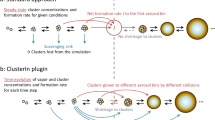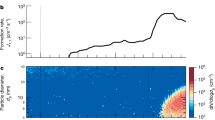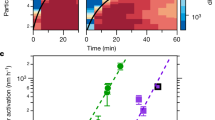Abstract
The formation of new atmospheric particles with diameters of 3–10 nm has been observed at a variety of altitudes and locations. Such aerosol particles have the potential to grow into cloud condensation nuclei, thus affecting cloud formation as well as the global radiation budget. In some cases, the observed formation rates of new particles have been adequately explained by binary nucleation, involving water and sulphuric acid1, but in certain locations—particularly those within the marine boundary layer1,2 and at continental sites1,3—observed ambient nucleation rates exceed those predicted by the binary scheme. In these locations, ambient sulphuric acid (H2SO4) levels are typically lower than required for binary nucleation1, but are sufficient for ternary nucleation4 (sulphuric acid–ammonia–water). Here we present results from an aerosol dynamics model with a ternary nucleation scheme which indicate that nucleation in the troposphere should be ubiquitous, and yield a reservoir of thermodynamically stable clusters 1–3 nm in size. We suggest that the growth of these clusters to a detectable size (> 3 nm particle diameter) is restricted by the availability of condensable vapour. Observations of atmospheric particle formation and growth from a continental and a coastal site support this hypothesis, indicating that a growth process including ternary nucleation is likely to be responsible for the formation of cloud condensation nuclei.
This is a preview of subscription content, access via your institution
Access options
Subscribe to this journal
Receive 51 print issues and online access
$199.00 per year
only $3.90 per issue
Buy this article
- Purchase on Springer Link
- Instant access to full article PDF
Prices may be subject to local taxes which are calculated during checkout



Similar content being viewed by others
References
Weber, R. J. et al. New particle formation in the remote troposphere: A comparison of observations at various sites. Geophys. Res. Lett. 26, 307–310 (1999).
Covert, D. S., Kapustin, V. N., Quinn, P. K. & Bates, T. S. New particle formation in the marine boundary layer. J. Geophys. Res. 97, 20581–20587 ( 1992).
Kulmala, M., Toivonen, A., Mäkelä, J. M. & Laaksonen, A. Analysis of the growth of nucleation mode particles observed in boreal forest. Tellus 50, 449–462 (1998).
Korhonen, P. et al. Ternary nucleation of H2SO4, NH 3, and H2O in the atmosphere. J. Geophys. Res.104, 26349–26353 ( 1999).
Clarke, A. D. Atmospheric nuclei in the remote free troposphere. J. Atmos. Chem. 14, 479–488 (1992).
Schröder, F. & Ström, J. Aircraft measurements of submicrometer aerosol particles (> 7 nm) in the midlatitude free troposphere and tropopause region. Atmos. Res. 44, 333 –356 (1997).
Raes, F., Van Dingenen, R., Cuevas, E., Van Velthoven, P. F. J. & Prospero, J. M. Observations of aerosols in the free troposphere and marine boundary layer of the subtropical Northeast Atlantic: Discussion of processes determining their size distribution. J. Geophys. Res. 102, 21315– 21328 (1997).
Hoppel, W. A., Frick, G. M., Fitzgerand, J. W. & Larson, R. E. Marine boundary layer measurements of new particle formation and the effects nonprecipitating clouds have on aerosol size distribution. J. Geophys. Res. 99, 14443–14459 ( 1994).
Van Dingenen, R., Raes, F. & Jensen, N. R. Evidence for anthropogenic impact on number concentration and sulphate content of cloud-processed aerosol particles over the North Atlantic. J. Geophys. Res. 100, 21057– 21067 (1995).
Weber, R. J. et al. A study of new particle formation and growth involving biogenic trace gas species measured during ACE-1. J. Geophys. Res. 103, 16385–16396 (1998).
Clarke, A. D. et al. Particle production in the remote marine atmosphere: Cloud outflow and subsidence during ACE 1. J. Geophys. Res. 103, 16397–16409 (1998).
O'Dowd, C. et al. On the photochemical production of biogenic new particles in the coastal boundary layer. Geophys. Res. Lett. 26, 1707–1710 (1999).
Hegg, D. A., Radke, L. F. & Hobbs, P. V. Measurements of Aitken nuclei and cloud condensation nuclei in the marine atmosphere and their relation to the DMS-cloud-climate hypothesis. J. Geophys. Res. 96, 18727– 18733 (1991).
Wiedensohler, A. et al. Occurrence of an ultrafine particle mode less than 20 nm in diameter in the marine boundary layer during Arctic summer and autumn. Tellus B 48, 213–222 (1996).
Pirjola, L., Laaksonen, A., Aalto, P. & Kulmala, M. Sulphate aerosol formation in the Arctic boundary layer. J. Geophys. Res. 103, 8309–8322 (1998).
Kerminen, V. -M. & Wexler, A. S. Post-fog nucleation of H2SO4-H2O particles in smog. Atmos. Environ. 28, 2399–2406 (1994).
Kerminen, V. -M. & Wexler, A. S. The occurrence of sulphuric acid-water nucleation in plumes: Urban environment. Tellus B 48, 65–82 ( 1996).
Mäkelä, J. M. et al. Observations of ultrafine aerosol particle formation and growth in boreal forest. Geophys. Res. Lett. 24, 1219–1222 (1997).
Easter, R. C. & Peters, L. K. Binary homogeneous nucleation: Temperature and relative humidity fluctuations, nonlinearity, and aspects of new particle production in the atmosphere. J. Appl. Meteorol. 33, 775–784 ( 1994).
Nilsson, E. D. & Kulmala, M. The potential for atmospheric mixing processes to enhance the binary nucleation rate. J. Geophys. Res. 103, 1381–1389 (1998).
Doyle, G. J. Self nucleation in the sulphuric acid-water system. J. Chem. Phys. 35, 795–599 (1961).
Raes, F., Saltelli, A. & Van Dingenen, R. Modelling formation and growth of H2SO 4-H2O aerosols: uncertainty analysis and experimental evaluation. J. Aerosol Sci. 23, 759– 771 (1992).
Kulmala, M., Laaksonen, A. & Pirjola, L. Parameterizations for sulphuric acid/water nucleation rates. J. Geophys. Res. 103, 8301– 8308 (1998).
Coffman, D. J. & Hegg, D. A. A preliminary study of the effect of ammonia on particle nucleation in the marine boundary layer. J. Geophys. Res. 100, 7147– 7160 (1995).
Raes, F. & Janssens, A. Ion-induced aerosol formation in a H2O-H2SO4 system. 1. Extension of the classical theory and search for experimental evidence. J. Aerosol Sci. 16, 217–227 (1985).
Stolzenburg, M. R. & McMurry, P. H. An ultrafine aerosol condensation nucleus counter. Aerosol Sci. Technol. 14, 48–65 (1991).
Weber, R. J. et al. Inversion of ultrafine condensation nucleus counter pulse height distributions to obtain nonaparticle (∼3 to 10 nm) size distributions. J. Aerosol Sci. 29, 601– 615 (1998).
Hörrak. U., Salm, J. & Tammet, H. Bursts of intermediate ions in atmospheric air. J. Geophys. Res.103, 13909–13915 (1998).
Reischl, G. P., Mäkelä, J. M., Karch, R. & Necid, J. Bipolar charging of ultrafine particles in the size range below 10 nm. J. Aerosol Sci. 27, 931–949 (1996).
Pirjola, L. Effects of the increased UV radiation and biogenic VOC emissions on ultrafine aerosol formation. J. Aerosol. Sci. 30, 355–367 (1999).
Acknowledgements
We thank R. J. Charlson and C. D. O'Dowd for helpful comments.
Author information
Authors and Affiliations
Corresponding author
Rights and permissions
About this article
Cite this article
Kulmala, M., Pirjola, L. & Mäkelä, J. Stable sulphate clusters as a source of new atmospheric particles. Nature 404, 66–69 (2000). https://doi.org/10.1038/35003550
Received:
Accepted:
Issue Date:
DOI: https://doi.org/10.1038/35003550
This article is cited by
-
Temporal variations, transport, and regional impacts of atmospheric aerosol and acid gases close to an oil and gas trading hub
International Journal of Environmental Science and Technology (2023)
-
Trace Gas Pollutants Led to New Particle Formation and a Strong Convective System Over Telangana, India
National Academy Science Letters (2023)
-
Sulfuric acid decomposition chemistry above Junge layer in Earth's atmosphere concerning ozone depletion and healing
Communications Chemistry (2019)
-
Electrospray Ionization–Based Synthesis and Validation of Amine-Sulfuric Acid Clusters of Relevance to Atmospheric New Particle Formation
Journal of the American Society for Mass Spectrometry (2019)
-
Growth rates of fine aerosol particles at a site near Beijing in June 2013
Advances in Atmospheric Sciences (2018)
Comments
By submitting a comment you agree to abide by our Terms and Community Guidelines. If you find something abusive or that does not comply with our terms or guidelines please flag it as inappropriate.



